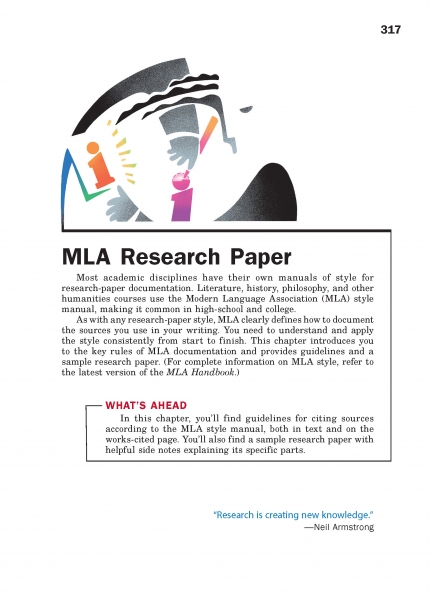Page 317 from

Start-Up Activity
Ask students to envision the layout of a movie theater:
- A ticket window fronts the building.
- A ticket taker greets you at a turnstile or entry lane through which you enter a main atrium.
- Straight ahead are concessions.
- Beyond, you find hallways to doorways with signs marking which screens show which movies.
Moviegoers can easily navigate just about any theater.
Explain that the MLA system shares a similar goal. It provides a consistent format for research writing. In the past, student researchers could never be sure what format their instructors would want them to follow. That meant creating end notes and a complete bibliography in one class and a footnotes and a working bibliography in the next. The Modern Language Association alleviates some of the frustration and burden by establishing a stable set of rules for formatting papers and citing research. This chapter clarifies the rules outlined in the 8th edition of the MLA Handbook and provides a sample MLA paper so that students can see the rules in action.
Students should refer to these other chapters in the Research Center to help them complete their work:
Think About It
“Your consistency says a lot about your commitment.”
– Rasheed Ogunlaru

Start-Up Activity
Ask students to envision the layout of a movie theater:
- A ticket window fronts the building.
- A ticket taker greets you at a turnstile or entry lane through which you enter a main atrium.
- Straight ahead are concessions.
- Beyond, you find hallways to doorways with signs marking which screens show which movies.
Moviegoers can easily navigate just about any theater.
Explain that the MLA system shares a similar goal. It provides a consistent format for research writing. In the past, student researchers could never be sure what format their instructors would want them to follow. That meant creating end notes and a complete bibliography in one class and a footnotes and a working bibliography in the next. The Modern Language Association alleviates some of the frustration and burden by establishing a stable set of rules for formatting papers and citing research. This chapter clarifies the rules outlined in the 8th edition of the MLA Handbook and provides a sample MLA paper so that students can see the rules in action.
Students should refer to these other chapters in the Research Center to help them complete their work:
Think About It
“Your consistency says a lot about your commitment.”
– Rasheed Ogunlaru